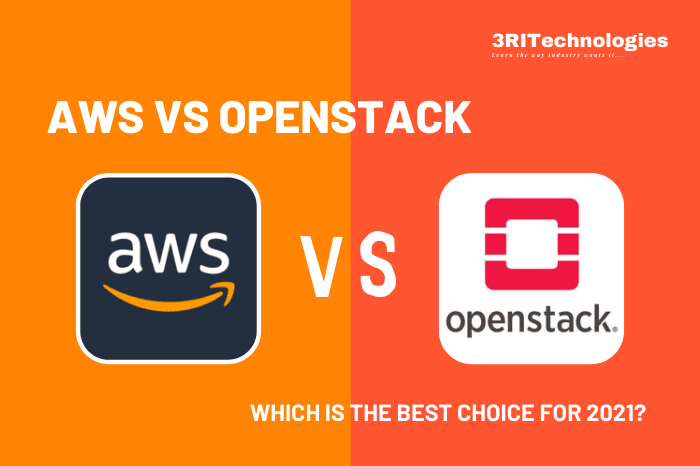AWS and OpenStack are the two established cloud service providers. AWS is a platform where one can perform primarily any process. It can be a Big Data platform, storage, ML platform processing unit, etc. It charges significantly less amount for these platforms, hence very affordable.
As cloud computing reshapes modern IT infrastructure, choosing between AWS and OpenStack can significantly impact your career path. While AWS offers unmatched scalability and managed services, OpenStack provides an open-source alternative that empowers organizations with flexibility and control. Understanding what is OpenStack, its core components, and OpenStack architecture is crucial for professionals exploring cloud computing OpenStack solutions. This guide will help you compare both platforms and decide which aligns best with your goals. If you’re looking to advance in cloud, consider expert-led AWS certification training from 3RI Technologies.
Understanding OpenStack Architecture and AWS Capabilities
Amazon is the first architect of cloud-based web services. These cloud-based solutions were introduced over a decade ago. Today efficient web services are a major requirement for the growth and success of an organization. Amazon has several deals or features for organizations. They can choose from these features according to their requisites. It is the most accepted platform among cloud services. Amazon offers its services through a network of multiple data centers or service providers. These data centers are spread all over the world. AWS’s services are computing, database-related, delivery of content and its storage, operating system, and networking methods. Clients can choose from the offered services according to their preferences. Check out DevOps with AWS Training offered at 3RI Technologies which has 30% Theory class and 70% practical hands-on training.
AWS Lambda functions, Amazon Kinesis Streams, Amazon SQS Queue, are the services used to collect the humongous data. The remarkable thing here is that all these data collection services are serverless. Amazon also has the features to watch over business cloud infrastructure. The powerful management tools are there to guard the data activities in the organization. AWS CloudTrail and Amazon CloudWatch are the management tools that can be used for this purpose. These can be used to track both data activities and user actions. But two of the pulling back features are charges for every needed facility and default service limits.
Introduction to OpenStack
Considering OpenStack, it is an open-source cloud computing platform. It uses collective virtual resources to take care of public and private clouds. Here Virtualisation is about abstracting resources such as storage, CPU, and RAM from the different vendor-specific procedures before the distribution. OpenStack has a constant set of application interfaces to further decrease these virtual resources’ presence a step into separate pools. These pools empower standard cloud computing tools. Administrators and users are in direct contact with these tools. The tools that contribute to the OpenStack platform are called “projects.” Sign up for the best AWS and DevOps Course!
It allows the business to control large storage, computation, and network clusters in a data center. These data centers can be managed through a dash console or Application Interface based on OpenStack. Among its key benefits is that its users can handle the owner’s source code. They can alter it and share the code with the community. OpenStack favors all open-source technologies and goes well with all commonly used software. Thus, it is taken as a good solution for varied infrastructure.
AWS vs. OpenStack
AWS and OpenStack are both very well-known in cloud computing fields. They have a large community of customers globally. Though AWS is more prevalent in the market, OpenStack is also on the way to establishing itself. Choosing between the both depends on the organization’s requirement. It isn’t easy to decide which of them is better. To choose between them depends on the need of the organizations.

Look at some of the differences between AWS and OpenStack of the technologies:
1. Computation
The procedure means computation to use a virtual server to run an application. AWS is unique with context to its scalable virtual network EC2 that operates flawlessly with Xen and EMR, Hadoop (distributed computing technology) based Big Data tools. AWS can develop further across servers by adding the machines to the available resources without increasing the CPU or RAM.
OpenStack has an IaaS (Infrastructure as a Service) method that is a device to proceed horizontally. Here it is necessary to mention that OpenStack does not provide any organized support.
2. Networking
In the company’s the admin decides how the peoples working for the business connect. The right user should have access to the right resources. These connections are known as networks. To create this network, the primary server is linked to other internal or external servers.
Amazon web services has a cloud domain system named Route 53. It can connect businesses to end-users. It is a very cost-effective and reliable method. This service forms a connection between user requests and instances, which is the part of AWS. These instances running in AWS maybe load balancers such as ELB (Elastic load balancing), Amazon S3 buckets, or Amazon EC2 instances. AWS itself will assign IP addresses to models which run on DHCP, ELB provides support to give incoming traffic to EC2 instances. Amazon 53 can also be used to connect users to Instances outside of AWS.
Check out AWS Cloud Practitioner Training and get certified today.
OpenStack LBaas (load balancing as a service) balances the load in private cloud environments. OpenStack uses VLAN technology, using which multiple independent switches can be created with a single switch. Using this technology, two users connected to the same switch but different VLANs cannot see each other’s traffic. So, OpenStack can separate the traffic of two various projects despite running on the same compute host. OpenStack provides the benefit of creating IP addresses and networks automatically as well as manually.
3. Storage
Storage is the fundamental which needs to be considered while choosing between cloud technologies. Block storage, object storage, and File storage are the three basic storage types associated with cloud computing services. Apart from that, AWS and OpenStack have some differences in storing data. Block storage is for storing unstructured data. Major storage, which is Block storage systems, keeps system files of the running virtual machines, supporting databases, and random read/write operations. Blocks and Volumes are there to store data, and evenly sized blocks make up files. Every block is assigned its address. Object storage takes care of data and links it to connected metadata. For block storage operations, AWS has EBS, and OpenStack has Cinder. For object storage, AWS has Amazon S3, and OpenStack has Swift.
4. Security
Organizations must keep their data secure. They need to authenticate the users before they access the data. Whenever an instance is created, a separate security group(s) is assigned to it. The Security measures provided by AWS are more powerful than OpenStack. With AWS data, when transferred to the cloud, it is TLS encrypted. Users can keep track of virtual networking infrastructure.
Get certified in Cloud Computing with Amazon Web Services Course at 3RI Technologies.
5.Identity
The essential function: Who will be given access to What? Identity servers are there to implement multifactor access authentication in the cloud. Its primary objective is to manage the user identity information and the user’s authentication to access services, applications, data, and other computer resources. It helps in reducing security breaches. The application used for identity in OpenStack is Keystone, and for AWS, it is IAM. The user’s identifications run all other applications. Identification of users is the first step leading to data security, and AWS is far ahead of OpenStack.
Interested to begin a career in AWS? Enroll now for AWS Online Training.
6. Private cloud architecture
AWS and OpenStack are also different in the way they form the private cloud architecture. There is a difference between the ways AWS and OpenStack build the private cloud. AWS Outposts extends the public cloud services into the on-premises data centers or private clouds. Using these frameworks, the same services can be executed on the public cloud like AWS EC2 instances on the on-premises hardware. Same public cloud monitoring and management tools can be used with private clouds.
OpenStack differs as it does not rely on a public cloud platform. It helps users install their cloud services using OpenStack Components, building core infrastructure functionality for OpenStack private clouds. But to access these functionalities, Organisations have to pay high costs. So, it becomes less preferable than AWS technology.
7. Management:
Fundamentally, OpenStack is an open-source cloud computing technology. It does not provide any official support or management services from the developers. To get this facility, a third-party OpenStack specialist is needed. This drawback proved fatal in the progress of OpenStack. On the other hand, AWS Outposts comes with built-in management support. But this feature has made AWS costlier than OpenStack. With AWS, there are also some hardware compatibility restrictions.

A Career in Open Stack vs. AWS
Careers in AWS and Open Stack have their specific units of advantages. AWS boasts wide purchasers, ranging from budding startups to installed organizations. Roles in AWS management offer first rate visibility and scope for innovation. Conversely, Open Stack caters to a spot marketplace with complex, outstanding use instances. It’s a playground for innovators and hazard-takers, supplying tough scenarios to decorate trouble-solving abilities.
Taking AWS as a career manner staying up-to-date with one of the quickest-developing and dynamic cloud service vendors. AWS certifications can propel your career, selling your abilities and making you sought-after in the market. On the alternative hand, Open Stack is the suitable desire for those interested in open-source technology. Learning Open Stack can open doors to excessive-tier process positions reserving autonomy and control over software and structures?
The difference between AWS and Open Stack is therefore a count of private preference: a vast consumer-base vs. a nuanced market, manage over carrier or manipulate over software. These technologies are much less competitors and extra complementary equipment in our increasingly cloud-reliant global. At 3rit Technologies, we enable our employees to make knowledgeable decisions about their profession direction, providing them with resources to discover and grasp both AWS and Open Stack.
Use Cases of AWS and Open Stack, and Career Prospects
The virtual technology is redefining conventional agency architectures, selling the adoption of cloud solutions like Amazon Web Services (AWS) and Open Stack. As a tech-savvy business enterprise, 3rit Technologies specializes in those structures, supplying our customer’s possibility to stay ahead of the curve even as presenting our employees with a wealthy career route.
The AWS cloud provider has emerged as a backbone for several groups, website hosting giant infrastructures on an elastic, stable, and simple-to-use platform. AWS renders scalable storage, advanced databases, and gadget gaining knowledge of programs, making it best for organizations of all bureaucracy and sizes. For example, Netflix leverages AWS to save and distribute its content to its consumer base, emphasizing its scalability and big statistics capacities.
Similarly, Open Stack, an open-source software program platform, helps advanced virtualization of compute power and community assets. It’s the cross-to preference for those looking for to establish a personal cloud, providing manage over hardware and enhancing facts security. The banking region, being privateers-targeted and data-in depth, greatly advantages from Open Stack’s strong shape. At 3rit Technologies, we provide a road to discover AWS and Open Stack, constructing a riveting tech profession. We apprehend the growing demand for cloud technology experts and foster an environment conducive to getting to know and applying this in-call for abilities.
So, we can conclude that although both AWS and OpenStack are suitable for cloud computing services, AWS comes with built-in solid support services and security for the organizations. The obvious question that popups in our mind are from which training institute we can get comprehensive knowledge about AWS, for this question the answer would be, you should visit 3RI Technologies once. From where we can get ourselves trained to start our career as AWS professionals. Here one should go through the curriculum of AWS Training in Pune provided in 3RI Technologies.
At 3RI Technologies, AWS Online Training is provided by seasoned AWS professional to make sure that trainees will not only have theoretical knowledge of the subject, but they will also have exposure to real-time business scenarios so that when they will start the career in the AWS world, it will not be unknown territory for them.
FAQs
- How is OpenStack Different from AWS?
The significant difference between AWS and OpenStack is that OpenStack needs to be built from scratch, while AWS is already there. Building cloud infrastructure from scratch requires substantial upfront expenses, like setting up a data center, buying hardware, paying a cloud deployment consultant, etc. For this reason, AWS is often a better choice at the start of the cloud migration process. In the end, all you have to do is sign up for an AWS account and link a credit card to it. Then, you can start using cloud services right away. AWS will charge you based on how many resources you actually use.
But as the amount of work grows, those costs can quickly become a big problem. Over time, the total cost of using AWS may be higher than setting up OpenStack. Running cloud infrastructure on-premises has ongoing expenses, like hosting, power use, staff salaries, etc. But, according to a study, these costs are lower when running workloads over a long period and at a large scale.
2. Is AWS More Secure Than OpenStack?
AWS (Amazon Web Services) and OpenStack security comparison is not a simple, one-size-fits-all evaluation. Cloud security is a shared responsibility, which means that users and service providers both have essential duties when it comes to protecting their environments.
One of the top cloud service providers, AWS, places a strong emphasis on security. Data encryption, firewalls, identity and access management, and compliance certifications are just a few security features and services it provides. To assist users in safeguarding their resources, AWS also offers security-related services like Amazon GuardDuty and AWS WAF, in addition to solutions like AWS Identity and Access Management (IAM). Because of its extensive ecosystem and ongoing security updates, AWS is an excellent option for businesses looking for a safe cloud infrastructure.
In contrast, OpenStack is an open-source platform that can create hybrid and private clouds. Users’ configuration and management of their OpenStack environments have a significant impact on their security. Although OpenStack offers several security components, it is the responsibility of users to install, configure, and maintain them properly.
With a vast array of pre-built security features and tools, AWS, in summary, provides a more straightforward and all-encompassing approach to cloud security. OpenStack’s open-source nature offers flexibility, but it also puts more of a burden on users to make sure their environments are configured and kept secure. Ultimately, how well businesses use the resources at their disposal, and their level of experience safeguarding cloud resources will determine how secure any platform is.
3. Can We Install OpenStack on AWS?
Indeed, you may run OpenStack on AWS, but as AWS is a cloud platform in and of itself, this may appear contradictory. Installing OpenStack on AWS can be helpful in certain situations when you need specific customization, extra control, or to investigate OpenStack’s potential, as it is generally used to develop private or hybrid cloud environments.
The usual steps to install OpenStack on AWS are as follows:
Launch EC2 Instances: To begin, create an EC2 instance on Amazon.com. Your OpenStack deployment will be built on top of these instances. Ensure the instances’ CPU, RAM, and storage meet all OpenStack’s hardware specifications.
Network Configuration: To isolate and secure your OpenStack environment, set up a Virtual Private Cloud (VPC) and configure network routes, security groups, and subnets as necessary.
Install OpenStack Components: Several OpenStack components, including Keystone (identity), Cinder (block storage), Neutron (networking), and Nova (computing), must be installed and configured. This might be a complex procedure that has to be carefully planned.
Database and Message Queue: OpenStack depends on a message queue service (like RabbitMQ) and a database server (usually MySQL). Install and set up these services to be compatible with your OpenStack setup.
Customization: You can define flavors, create networks, and manage instances in your OpenStack environment to suit your unique requirements.
Testing and Maintenance: Make sure your OpenStack deployment is operating correctly by giving it a thorough test. Maintaining the environment’s security and modernity will also require frequent upkeep and updates.
Although OpenStack can be installed on AWS, it’s crucial to keep in mind that AWS currently provides a large number of cloud services and resources. Specific use cases and requirements, such as personalizing your cloud environment, setting up a particular testing or development environment, or satisfying regulatory compliance requirements, should guide the decision to operate OpenStack on AWS.





